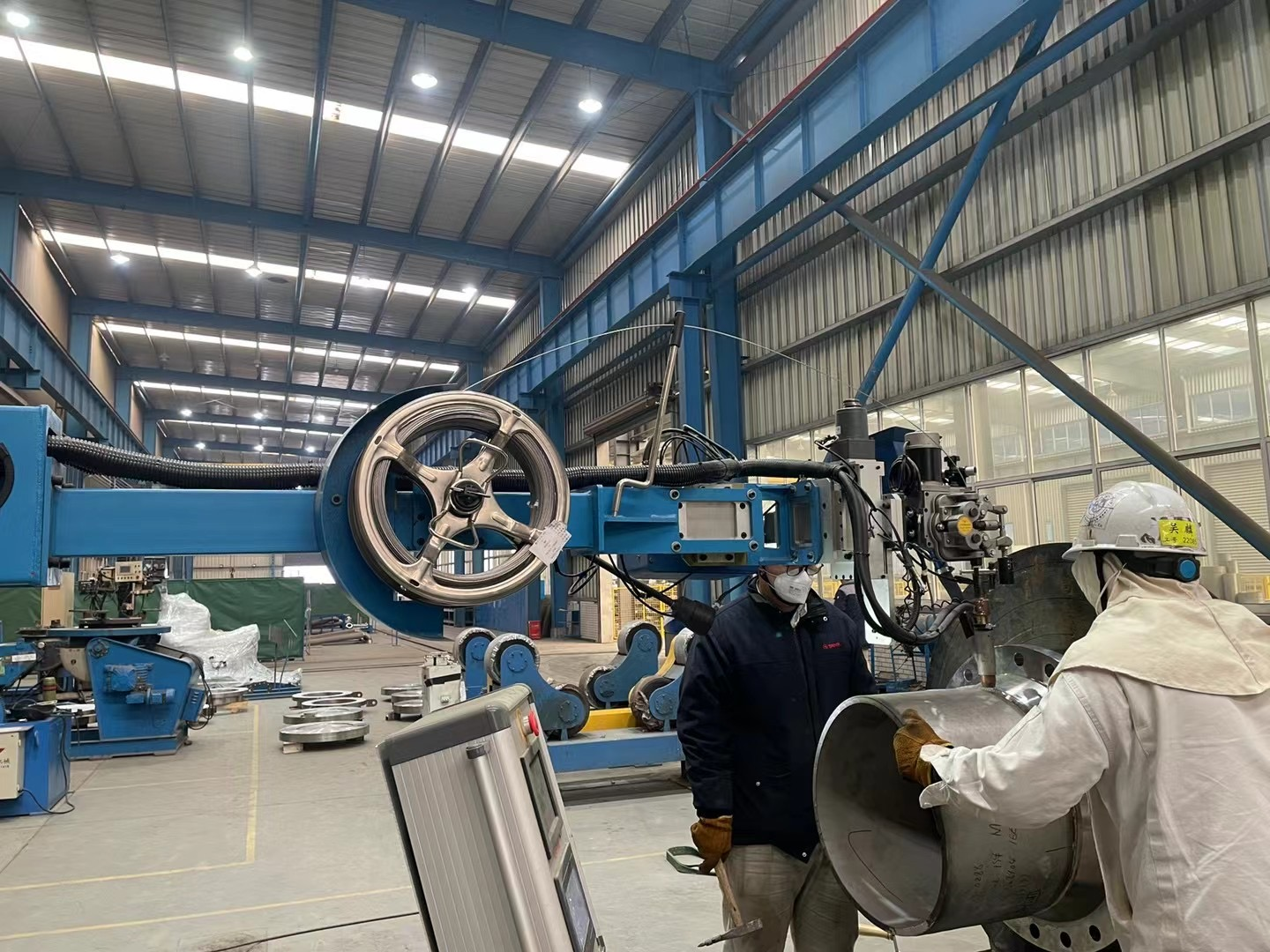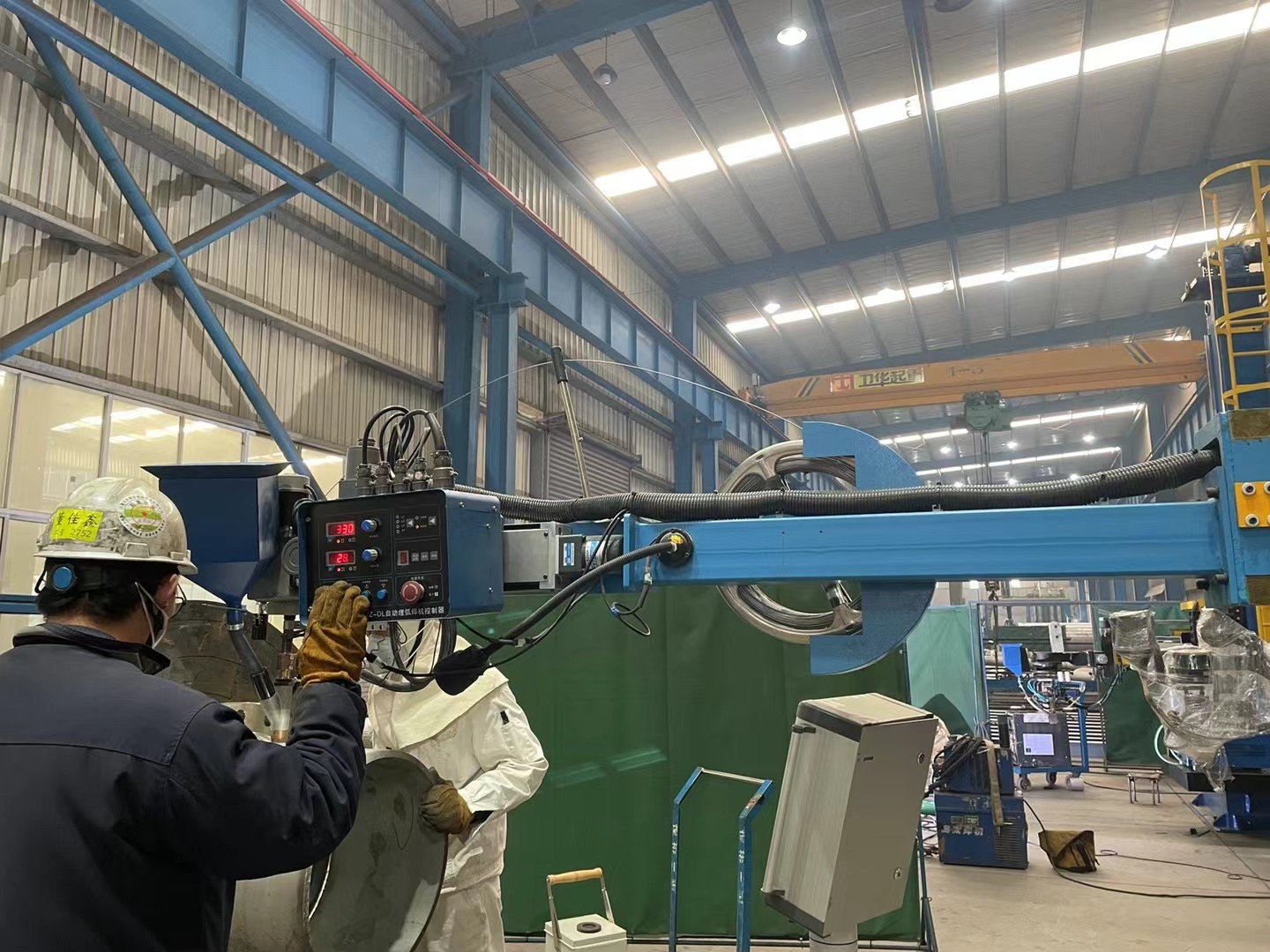In modern pressure vessel manufacturing workshops, an impressive scene is reshaping traditional welding processes: vessel cylinders weighing tens of tons rotate precisely on heavy-duty welding positioners, while welding torches mounted on large column manipulators follow pre-programmed paths for perfect welds. This seemingly simple equipment combination is fundamentally transforming the efficiency and quality standards of pressure vessel manufacturing. As global chemical and energy industries continue to raise safety requirements for pressure vessels, vessel dimensions and wall thicknesses keep increasing, with manufacturing complexity growing exponentially. Traditional manual welding methods can no longer meet the stringent demands for weld quality and production efficiency in modern pressure vessels.
The emergence of automated welding systems provides pressure vessel manufacturers with perfect solutions. The collaborative work between welding positioners and manipulators creates an ideal welding environment: workpieces rotate at uniform speeds, while welding torches maintain precise positioning. This combination not only ensures process stability but also guarantees that every weld is completed in the optimal position. For thick-walled pressure vessels requiring multi-layer, multi-pass welding, this stability means each weld layer can perfectly fuse, forming a dense and uniform weld structure.
Welding Challenges and Innovative Solutions in Pressure Vessel Manufacturing
As critical equipment bearing high-temperature and high-pressure media, the welding quality of pressure vessels directly affects the safe operation of entire industrial systems. Modern large pressure vessels now exceed 20 meters in height, with diameters reaching 4-6 meters, and single unit weights often surpassing hundreds of tons. Such massive workpieces present numerous challenges during welding: continuity in circumferential seams, straightness in longitudinal seams, uniformity of heat input, and most critically, operator safety issues.
Heavy-duty welding positioners provide an ideal rotating platform for pressure vessel welding through their powerful load capacity and precise speed control. Combined with the accurate positioning of column-style manipulators, this enables precise control of welding torches in three-dimensional space. This combination solves the most challenging problem in traditional welding—how to maintain large workpieces in the optimal position throughout the welding process. In practical applications, this automated system can increase welding efficiency by 3-5 times while improving first-pass weld qualification rates to over 99.8%.
Technological Breakthroughs for Achieving Excellent Weld Quality
In pressure vessel manufacturing, the quality of circumferential welds is crucial. The success of vessel circumferential welding depends on two key factors: stable rotation speed and precise torch positioning. Precision positioning equipment achieves stepless speed regulation within the 0.1-120 rpm range through advanced servo control systems, ensuring absolute stability in welding speed. This stability directly affects heat input uniformity, which is key to avoiding welding defects.
Simultaneously, large manipulator machines maintain optimal distance and angle between the torch and workpiece through their sturdy column structures and precise motion control systems. Even for longitudinal seams spanning tens of meters, they ensure full-length straightness and uniform weld formation. This precision control is vital for ensuring pressure vessel roundness and straightness, directly impacting equipment service performance and safety reliability.

Specific Applications of Automated Welding Systems in Pressure Vessel Manufacturing
In modern pressure vessel manufacturing plants, the combination of welding positioners and manipulators has formed standardized production units. Typical configurations include one heavy-duty positioning system and one large column manipulator, with the option to add a second driven positioner to support extra-long vessel sections. This setup can accommodate welding requirements for vessels with diameters of 2-8 meters, lengths up to 30 meters, and weights reaching 200 tons.
The system demonstrates exceptional adaptability for welds in different positions. For internal and external circumferential seams, the positioner rotates the workpiece while the manipulator’s torch remains fixed, achieving perfect flat position welding. During longitudinal seam welding, the positioner secures the workpiece while the manipulator moves the torch along the guide rail to complete vertical welding. This flexibility allows one system to handle most of the vessel’s welding tasks, significantly improving equipment utilization.
Welding Solutions for Complex Structural Components
With increasingly complex pressure vessel designs, welding various special-shaped structural components presents new challenges. The welding of conical heads, elliptical heads, and various irregular nozzles requires higher flexibility and precision from equipment. Intelligent welding systems achieve dynamic parameter adjustment during welding through coordinated control.
When welding complex structural components, adjustable welding positioners automatically adjust position and angle based on the workpiece’s geometry, ensuring each welding area is in the optimal position. Meanwhile, automated operating equipment continuously adjusts torch height and angle to maintain the best welding posture throughout the process. This intelligent coordinated control ensures consistent welding quality for every part of complex structures, providing reliable assurance for pressure vessel safety.
Key Considerations for Selecting Professional Welding Equipment
Choosing suitable welding equipment for pressure vessel manufacturing requires comprehensive consideration of multiple factors. First, equipment specifications must meet production requirements. The load capacity of heavy welding machinery should exceed the maximum workpiece weight by at least 30% to ensure operational stability and safety. The speed range of positioners must cover all possible welding process requirements, while the manipulator’s travel and precision must meet the welding needs of the largest workpieces.
Second is equipment reliability and durability. Pressure vessel welding involves high intensity and long durations, requiring equipment capable of withstanding continuous operation. Selecting reputable welding equipment manufacturers is crucial, as they typically use high-quality components and provide comprehensive technical support and service guarantees. Additionally, equipment intelligence level is an important consideration; modern automated welding equipment should feature data collection, fault diagnosis, and remote monitoring capabilities.
Equipment Configuration and System Integration Essentials
When configuring welding systems, several technical details require special attention. The drive method of positioners directly affects speed stability, with servo drive systems offering better control precision than traditional frequency conversion drives. The structural rigidity of manipulators determines welding stability, with double-column structures providing better anti-deformation capability than single-column designs. For extra-long vessel welding, synchronized control of multiple positioners must also be considered.
Professional equipment suppliers typically offer complete solutions including equipment selection, site planning, installation commissioning, and operator training. They also provide customized function development based on specific customer needs, such as welding procedure packages for specific materials or data interfaces for factory MES system integration. These value-added services help enterprises achieve the benefits of automated welding more quickly.

Future Development Trends and Intelligent Upgrade Paths
With the deepening application of Industry 4.0 technologies, the combination of welding positioners and manipulators is evolving toward comprehensive intelligence. Next-generation smart welding solutions will integrate more sensors and advanced control algorithms to achieve autonomous optimization and quality prediction of the welding process. Through machine learning technology, systems can learn optimal welding parameters from historical data and make dynamic adjustments based on real-time working conditions.
The application of digital twin technology will bring revolutionary changes to pressure vessel manufacturing. Digital production lines constructed in virtual space can real-time map the operating status of physical equipment for process optimization and fault prediction. Operators can remotely manage multiple welding workstations through intelligent monitoring platforms, significantly improving management efficiency and production flexibility.
Technological Innovation in the Context of Sustainable Development
In the context of carbon neutrality, pressure vessel manufacturing faces higher requirements for energy conservation and environmental protection. New-generation welding equipment is developing toward greater energy efficiency and environmental friendliness. High-efficiency welding systems incorporate regenerative energy technology to feed braking energy back to the grid, reducing operating costs. Intelligent power management functions can optimize energy usage efficiency in real-time based on welding process requirements.
Meanwhile, equipment manufacturers are paying more attention to material recyclability and equipment’s full lifecycle environmental performance. Through modular design, modern welding machinery becomes easier to upgrade and refurbish, extending equipment service life and reducing resource waste. These innovations not only lower operating costs for manufacturing enterprises but also contribute to the sustainable development of the entire pressure vessel industry.
The perfect combination of welding positioners and manipulators has established new quality standards and efficiency benchmarks for pressure vessel manufacturing. This automated welding solution not only solves the technical challenges of large component welding but also brings significant competitive advantages to pressure vessel manufacturers. As manufacturing technology continues to advance and market competition intensifies, investing in advanced welding equipment has become an inevitable choice for pressure vessel manufacturing enterprises.
Selecting appropriate professional equipment partners and establishing long-term strategic cooperation relationships can ensure continuous support for technology updates and equipment maintenance. In the future, with deeper application of intelligent technologies, the collaboration between welding positioners and manipulators will become even closer, providing more efficient and reliable manufacturing solutions for the pressure vessel industry, supporting the continuous development of global energy and chemical equipment manufacturing.
welding equipment manufacturers:
heavy-duty welding positioner:
automated welding equipment:
adjustable welding positioner:
heavy-duty positioning system:
https://www.weldmc.com/product-category/welding-automation/welding-positioner
column-style manipulator:
https://www.weldmc.com/product/welding-manipulator/
